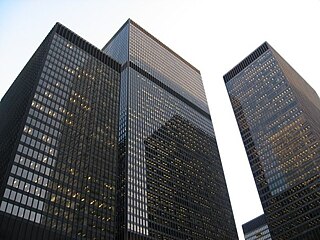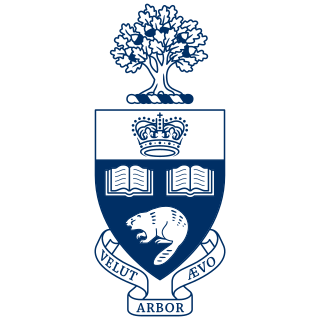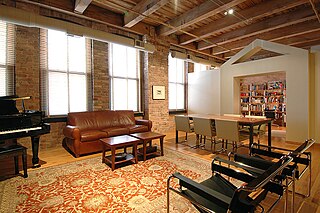
Renzo Piano, is an Italian architect. His notable buildings include the Centre Georges Pompidou in Paris, The Shard in London (2012), and the Whitney Museum of American Art in New York City (2015) and Stavros Niarchos Foundation Cultural Center in Athens (2016). He won the Pritzker Architecture Prize in 1998.

The Toronto–Dominion Centre, or TD Centre, is a cluster of buildings in downtown Toronto, Ontario owned by Cadillac Fairview. It has six towers and a pavilion covered in bronze-tinted glass and black painted steel. It serves as the global headquarters of the Toronto-Dominion Bank, and provides office and retail space for many other businesses. About 21,000 people work in the complex, making it the largest in Canada.

Jatiya Sangsad Bhaban or National Parliament House, is the house of the Parliament of Bangladesh, located at Sher-e-Bangla Nagar in the Bangladeshi capital of Dhaka. Designed by architect Louis Kahn, the complex is the largest legislative complexes in the world, comprising 200 acres.

St. Michael's Cathedral Basilica is the cathedral church of the Roman Catholic Archdiocese of Toronto, Canada, and one of the oldest churches in Toronto. It is located at 65 Bond Street in Toronto's Garden District. St. Michael's was designed by William Thomas, designer of eight other churches in the city, and was primarily financed by Irish immigrants who resided in the area. The cathedral has a capacity of 1600.

The Church of the Holy Trinity is an Anglican church in downtown Toronto, Ontario, Canada at Trinity Square.

Sainte Marie de La Tourette is a Dominican Order priory, located on a hillside near Lyon, France designed by the architect Le Corbusier, the architect’s final and most important building. The design of the building begun in May 1953 and completed in 1961. The committee that decided the creation of the building, considered that the primary duty of the monastery should be the spiritual awakening of the people and in particular the inhabitants of nearby areas. That's why the monastery was placed in Eveux-sur-Arbresle, which is just 25 km from Lyon and is accessible by train or car.

Hart House is a student activity centre at the University of Toronto. Established in 1919, it is one of the earliest North American student centres. Hart House was initiated and financed by Vincent Massey, an alumnus and benefactor of the university, and was named in honour of his grandfather, Hart Massey. The Collegiate Gothic-revival complex was the work of architect Henry Sproatt, who worked alongside decorator Alexander Scott Carter, and engineer Ernest Rolph, and subsequently designed the campanile at its southwestern corner, Soldiers' Tower.

College Park is a shopping mall, residential and office complex on the southwest corner of Yonge Street and College Street in Toronto, Ontario, Canada. An Art Deco landmark, the building was built between 1928 and 1930 by the Eaton's department store, and was designed by Ross and Macdonald, the Montreal architectural firm that also designed the Royal York Hotel and Maple Leaf Gardens in Toronto, the Château Laurier Hotel in Ottawa, and the Montreal Eaton's store.

The Mississauga Civic Centre is the seat of local government of Mississauga, Ontario, Canada. The 37,280 square metre complex is a prominent example of postmodern architecture in Canada, finished in 1987 by Jones and Kirkland. It stands at 92 metres or 302 feet. The design was influenced by farmsteads which once occupied much of Mississauga as well as historical features of city centres. The building, for instance, includes a prominent clock tower. It was chosen as the winner of a design competition that included 246 submissions. Mississauga Civic Centre is located near Square One Shopping Centre and is home to the Mississauga City Council.

Victoria Hospital for Sick Children is a building in Toronto, Ontario, Canada. The building served as a hospital until 1951 and currently serves as a blood centre. The building has received a Commendation of Adaptive Re-use from the Toronto Historical Board.

George Brown House is a historic building in the Grange Park neighbourhood of Toronto, Ontario, Canada. It was home to Father of Confederation, Reform Party politician and publisher George Brown. Its current address is 186 Beverley Street.

The Broadview Hotel is a 58 room boutique hotel in Toronto, Ontario, Canada. It is located at the intersection of Broadview Avenue and Queen Street East in Toronto's Riverside neighbourhood. Built in 1893, the building was originally a hall with retail and office space and later converted into a hotel. Until 2014, the establishment was occupied by the New Broadview House Hotel, a hotel and boarding house housing low-income persons with a strip club named Jilly's on its ground level. It was closed and converted to an up-scale establishment with several restaurants and a roof patio.

Contemporary architecture is the architecture of the 21st century. No single style is dominant; contemporary architects are working in a dozen different styles, from postmodernism and high-tech architecture to highly conceptual and expressive styles, resembling sculpture on an enormous scale. The different styles and approaches have in common the use of very advanced technology and modern building materials, such as Tube structure which allows construction of the buildings that are taller, lighter and stronger than those in the 20th century, and the use of new techniques of computer-aided design, which allow buildings to be designed and modeled on computers in three dimensions, and constructed with more precision and speed.

The Sacramento Masonic Temple, built between 1913 and 1918, is a five-story building on J Street in downtown Sacramento, California. The building was listed on the National Register of Historic Places in 2001.

The El Paso U.S. Courthouse, also known as El Paso Federal Building or the U.S. Court House, is a historic building in El Paso, Texas. It is a courthouse of the United States District Court for the Western District of Texas. The building was completed in 1936 and served historically as a courthouse and as a government office building. It is located at 511 East San Antonio Avenue. It was listed on the National Register of Historic Places in 2001.

The Jarvis Street Baptist Church is a Baptist church located at the intersection of Gerrard Street and Jarvis Street in downtown Toronto. One of the oldest churches in the city, its congregation was founded in 1818, and the present church constructed in 1875.
The Margaret Lyttle Memorial School Junior Campus is the junior campus of Preshil. It was designed by Kevin Borland. The buildings that Kevin Borland designed at the Preshil School are experimental in design and uses triangular and hexagonal geometries together with diagonals in both plan and section. This creates a variety of internal and external spaces, irregular forms and buildings that strongly deviates from the conventional school buildings of that time. The precise forme of each building and its detailing is counteracted by the use of raw timber posts and beams.

The Frank Tate Building, also known as building 189, is a Student Centre in the University of Melbourne, Victoria, Australia. Designed by Public Works Department Chief Architect Percy Edgar Everett, it was built in 1939/40 as an expansion of the Melbourne Teachers' College, housed in the grand '1888 Building' to the south. In 1994 the Melbourne Teachers College relocated and the building became part of the main Melbourne University Parkville Campus. It was refurbished as a learning centre by Cox architects in 2010, designed to allow a multitude of different user groups to configure the space according to their individual requirements.
Integral House is a private residence, located at 194 Roxborough Drive in the Rosedale neighbourhood of Toronto, Canada. The project was commissioned by James Stewart as a residence incorporating a performance space, and was designed by Brigitte Shim and Howard Sutcliffe of the Toronto architectural firm Shim-Sutcliffe Architects. The name of the house is derived from the mathematical integral symbol, commonly used in calculus; Stewart's wealth derived from his authorship of widely used calculus textbooks. It has won several architectural awards, including a 2012 Governor-General's Medal in Architecture. Glenn D. Lowry, director of the Museum of Modern Art, said of Integral House, "I think it's one of the most important private houses built in North America in a long time."

The Edificio del Seguro Médico in El Vedado was built between 1955 and 1958, designed as a mixed use building for apartments and offices for the headquarters of the National Medical Insurance Company, it is considered to be one of the best commercial buildings in Havana of the 50s and of the best modernist buildings overall including the FOCSA Building by Ernesto Gómez Sampera (1921–2004) and Martín Domínguez Esteban (1897-1970). The latter designed the Radiocentro CMQ Building. In regards to Edificio del Seguro Médico an architect from the Universidad de Oriente, Santiago de Cuba, Carlos Alberto Odio Soto made the following observation:
"Within the modern heritage architecture of the 50s, there is the Medical Insurance Building, work designed by the architect Antonio Quintana in 1955. This work was praised even before its inauguration by the prestigious Professor Pedro Martínez Inclán on the occasion of the delivery of the First Prize to the Project where he proposed that Quintana, when he managed to carry out his project, could blazon of having endowed Havana, according to the famous sentence of Paul Valery, "of a building that speaks." At the national level, Quintana received the recognition of the main specialized publications that circulated in the country at that time: Architecture, Space, Cuba Album, etc .; at the same time is diffused internationally through the book Latin American Architecture since 1945, published by the Museum of Modern Art in New York, and the Exhibition of Modern Cuban Architecture held in the city itself by the Architectural League. Almost at the end of the 50s, he receives two distinctions: in 1959 the Gold Medal Award of the National College of Architects and the condition of best commercial work of this period."






















